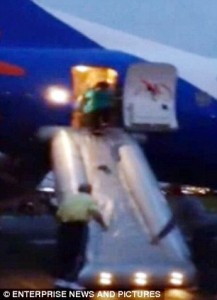On 19 Oct 2012 a B737 operated by Jet2 was on its take off roll when smoke was detected in the cabin. The Captain brought the aircraft to a quick stop and all 189 passengers evacuated the aircraft. I am guessing that the aircraft also had six crew who also evacuated. Some 17 passengers were reported to be injured during the evacuation, four of which were being treated in hospital.
The BBC headline on their website for this story states,
Glasgow Airport evacuation: Passenger tells of panic on Jet2 plane
http://www.bbc.co.uk/news/uk-scotland-20001291
Is this a fair account of the situation on board the Jet2 aircraft? Were people really behaving irrationally and in a selfish manner during this evacuation? Had social norms broken down, was it everyone for themselves? Or is this just another media exaggeration to sensationalise a story?
Other media accounts had more factual headlines, such as from the Express web site:
17 Injured as plane is evacuated at Glasgow Airport after smoke alert.
From the Telegraph web site we have:
Glasgow Airport Seventeen injured as aircraft aborts take off
From the Mail Online web site we have:
20 crew and passengers are INJURED in emergency evacuation by inflatable slides from jet at Glasgow airport after “engine” fills cabin with smoke.
Evacuating an aircraft is not something that people do every day, and so it is going to be an unusual experience for most people, and a frightening experience for most, especially if you believe, as these people must have, that a fire had started on board. All 189 passengers will also have to exit the aircraft in an awful hurry and in an unusual and physical manner i.e. jumping onto slides or climbing out of the overwing exit, onto the wing and then jump to the ground. The cabin crew will have been yelling at the passengers to evacuate, leave your bags, jump onto the slide, while the cabin was filling with acrid smoke. The passengers on board would have been a mix of people including; men, women, children, the elderly, family groups and possibly disabled people. They would have had a range of flying experience from frequent flyers to the ocassional flyer. Given this mix of people we would not expect everyone to react in the same way, and not everyone will react without emotion. But will panic really break out in this situation, will it be everyone for themselves, as the BBC headline suggests?
The opening sentence of the BBC article may give this impression,
“Passengers on an Alicante-bound plane from Glasgow Airport have described “sheer panic” after “swirling” smoke in the cabin forced an emergency stop.”
So what do the BBC base this on? A quote from one passenger was reported as,
“… passenger X said “people started running” as the pilot of the Jet2 737 shouted “get out, get out” following the emergency stop at 07:40.”….”
Well this seems quite normal given the situation, who wouldn’t be trying to run out of an aircraft filling with smoke with the captain and cabin crew yelling at you to get out! Indeed, you would be in a panicked state if you just froze on the spot and didn’t do anything — this is called negative panic or behavioural inaction. It is a normal behaviour to try and get out of the aircraft as quickly as possible, especially if the captain and cabin crew are yelling at you to get out!
The BBC inform us that one passenger was travelling with his young family and report the passenger as saying,
“I have a nine-week-old daughter and a four-year-old daughter. I had my nine-week-old attached to my chest as I went down the emergency chute and my wife had our four-year-old and was in tears. ……. It was just sheer panic, something no-one would want to go through again.”
Clearly this situation is extremely frightening and traumatic, especially if you have a wife, child and infant to look after, make your way to the emergency exit and then jump onto a slide — all while the other 185 passengers are trying to get out and the aircraft is filling with smoke. It is not surprising that there were tears and it is not surprising that they would have been extremely anxious and would have had adrenaline pumping. But the behaviour of this family does not sound like a panic behaviour. They kept together and assisted each other out of the aircraft. Their behaviour sounds like a rational response to the extra ordinary situation that they found themselves in. While the passenger uses the “P” word in his description it would have been helpful had the journalist gone on to ask the passenger to describe the scenes of panic that he reported. Often people will use the “P” word to describe people running away from danger, or people crying. This does not indicate that people were behaving in an irrational manner or that social norms are ignored.
The BBC also selectively quote another passenger’s account in their article and also helpfully include a recording of the interview. In the article the passenger is reported as saying,
“I was sitting in row 11 and I could smell smoke as we were accelerating hard. “I looked up. One or two passengers, including myself, had our reading light on and when I looked up to the lamps and the ceiling, I could actually see smoke swirling around and I thought, oops, there’s something not right here. “We were accelerating very, very hard down the runway at this stage and I was about to scream out to the cabin crew when obviously the pilot realised there was something wrong and he immediately throttled the engines back and put the brakes on. “It’s the hardest braking I’ve ever experienced in my life.”
This is where the BBC article leaves the interview. This selective quotation fits into the tone of the story that is being told by the journalist, smoke filling the aircraft and the dramatic stop. However, in the recorded interview, which is also available on the BBC website, the passenger goes on to say, but is not quoted in the article,
“….a few seconds later he gave the order to evacuate. Everybody got out of their seats, one or two passengers tried to reach into the overhead lockers to get their baggage but they were politely told in no uncertain Glaswegian terms just get out of the aircraft” both the journalist and the passenger laugh, “leave your bags and get out, but there was no panic”.
The passenger is describing an orderly behaviour and makes the observation that there was no panic. This unfortunately does not fit into the tone of the article and so is not reported. The journalist desperately tries to get back to possible stories of panic and extreme behaviour and goes onto to say,
“You are laughing about it now but that is probably not what you were feeling about it at the time.”
The passenger (helpfully) responds,
“..There was smoke coming off the right hand engine so I was going out the left overwing exit….we all wanted to get off as quickly as possible but it was all orderly, there was no panic.”
In describing his own behaviour the passenger paints a picture of rational behaviour, a clear thought process that lead him to select an appropriate exit. He also describes the behaviour of others as being orderly and states that there was no panic. Clearly this account does not fit with the tone of the article so it is not reported. The journalist rather go with the easy story, the story that is going to make a sensationalist headline, the story that is in-line with the publics hollywood feed expectations when it comes to evacuation stories — people panic!
While these two accounts are not sufficient to base a judgement on the nature of the evacuation from the Jet2 aircraft, they certainly do not support the BBC headline or the tone of the BBC story. I am sure that there were people screaming and crying during the evacuation, but this in itself is not an indication of panic behaviour. Indeed, the accounts in the BBC story support the understanding built up over the past 30+ years that on the whole people do not tend to panic in emergency situations. Indeed, quite the opposite, people tend to behave in a rational way and social norms are maintained even in the most extreme situations.
Unfortunately, this story simply perpetuates the myth that in emergency situations the norm is for people to panic. I think that a more interesting, uplifting story is that in emergency situations people tend not to panic, but tend to behave in a rational supportive manner and are more likely to assist others then selfishly think only of themselves.









